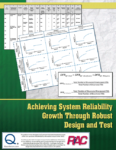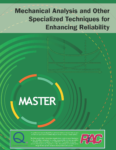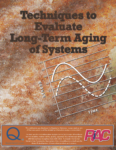Product Description
Quanterion Solutions is offering a one-time discount bundle of 15% off three select reliability hard copy products.
Achieving System Reliability Growth Through Robust Design and Test
 This book offers new definitions of how failures can be characterized, and how those new definitions can be used to develop metrics that will quantify how effective a Design for Reliability (DFR) process is in (1) identifying failure modes and (2) mitigating their root failure causes. Reliability growth can only occur in the presence of both elements.
This book offers new definitions of how failures can be characterized, and how those new definitions can be used to develop metrics that will quantify how effective a Design for Reliability (DFR) process is in (1) identifying failure modes and (2) mitigating their root failure causes. Reliability growth can only occur in the presence of both elements.
Learn more and view the excerpt.
Mechanical Analysis and Other Specialized Techniques for Enhancing Reliability (MASTER)

MASTER provides a thorough, in-depth discussion of competing approaches to predict the reliability and expected life of mechanical parts and systems, including Statistical Analysis of relevant failure data, Physics of Failure modeling, Empirical Failure Models and Data, and other less common but acceptable methods.
The document also describes the mechanical reliability process, including the role of these predictions and other necessary testing and analyses for the production of reliable mechanical systems, and the nature of mechanical failures, including a discussion of underlying failure mechanisms.
MASTER is recommended either as standalone or as a companion to Quanterion’s NPRD-2016, FMD-2016 and Techniques to Evaluate Long-Term Aging of Systems (LAST) publications.
Learn more and view the excerpt.
Techniques to Evaluate Long-Term Aging of Systems (LAST)
 The objective of this report is to highlight the impact of long-term aging effects on parts, assemblies and equipment by investigating characteristics of aging as they impact specific material classes.
The objective of this report is to highlight the impact of long-term aging effects on parts, assemblies and equipment by investigating characteristics of aging as they impact specific material classes.
Learn more and view the excerpt.



 This book offers new definitions of how failures can be characterized, and how those new definitions can be used to develop metrics that will quantify how effective a Design for Reliability (DFR) process is in (1) identifying failure modes and (2) mitigating their root failure causes. Reliability growth can only occur in the presence of both elements.
This book offers new definitions of how failures can be characterized, and how those new definitions can be used to develop metrics that will quantify how effective a Design for Reliability (DFR) process is in (1) identifying failure modes and (2) mitigating their root failure causes. Reliability growth can only occur in the presence of both elements.
 The objective of this report is to highlight the impact of long-term aging effects on parts, assemblies and equipment by investigating characteristics of aging as they impact specific material classes.
The objective of this report is to highlight the impact of long-term aging effects on parts, assemblies and equipment by investigating characteristics of aging as they impact specific material classes.